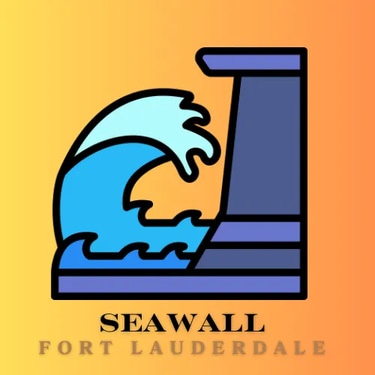How Often to Inspect Your Seawall
Wondering how often it takes to inspect your seawall? Learn expert inspection intervals, warning signs & tips. Book your inspection today!
SEAWALL INSPECTION
8/19/20254 min read


Seawall Inspection
How Often Should You Inspect Your Seawall in South Florida?
Owning or managing a waterfront property —is a valuable asset, but it also comes with important responsibilities. Chief among them is the regular inspection and maintenance of your seawall. These protective structures are essential for preventing shoreline erosion, flooding, and storm surge damage.
At Seawall Fort Lauderdale, we understand how critical these structures are for long-term coastal property protection. Yet many property owners don’t consider their seawall until it's already showing signs of failure.
So, the key question becomes: How often should you inspect your seawall in Fort Lauderdale?
This in-depth guide from Seawall Fort Lauderdale outlines recommended inspection intervals, signs of structural damage, seasonal risk factors, maintenance strategies, typical lifespans, and regulatory requirements relevant to all coastal communities in South Florida.
Why Regular Seawall Inspections Matter
Seawalls are engineered to hold back water and protect land from tidal forces, soil erosion, and storm surge. In Fort Lauderdale’s harsh marine environment, they face year-round pressure from:
Saltwater corrosion
High boat traffic and wave energy
King tides and fluctuating water levels
Tropical storms and hurricanes
Soil pressure and drainage buildup
Over time, these forces wear down structural components, potentially leading to:
Soil loss behind the wall
Cracked or leaning wall panels
Collapsed footings
Water intrusion
Foundation instability
Regular inspections ensure early damage is detected before it escalates into an emergency—and they help you remain compliant with Fort Lauderdale and Broward County seawall regulations.
How Often to Inspect Seawalls in Fort Lauderdale?
Seawallinspection services frequency depends on multiple factors: wall material, age, environmental exposure, and property type.
Recommended Inspection Intervals
Wall Surface - Cracks, leaning, fractures, visible deterioration
Cap and Panels - Concrete spalling, rust stains, structural breaks
Drainage Holes - Blockage, improper spacing, signs of pressure buildup
Toe & Base - Undermining, scour, marine life infestation
Soil Behind Wall - Sinkholes, erosion, soft soil
Anchoring Systems - Movement, corrosion, pullback issues
Compliance - Permit validation, code adherence
Note: Older seawalls (15+ years) or those made of wood should be inspected more frequently.
What Affects Seawall Inspection Frequency?
1. Material Type
Concrete: Durable but vulnerable to cracking and rebar corrosion
Vinyl: Resistant to corrosion but can warp or split under impact
Wood: High maintenance, susceptible to rot and marine borers
Steel: Structurally strong, but prone to rust in salty environments
2. Age of the Seawall
The older the seawall, the more vulnerable it is. Inspections should become more frequent with age—even if no damage is visible.
3. Location & Exposure
Seawalls in open water, high-wake zones, or storm-prone areas require closer monitoring than those in sheltered canals.
Seasonal Impacts on Your Seawall in South Florida
South Florida’s climate contributes to accelerated seawall deterioration:
Summer & Hurricane Season (June–November)
Highest risk of structural damage from storm surges, flooding, and wave impact
Must inspect before and after major storms
Storm debris and pressure shifts often reveal hidden vulnerabilities
Winter (December–February)
Water level fluctuations may expose the seawall base
Cooler temperatures can lead to cracking or cap damage in aging walls
Spring (March–May)
Ideal time for comprehensive inspection and minor repairs
Prepares your wall for summer rains and potential hurricanes
Fall (September–November)
Check for soil erosion, drainage issues, and pressure buildup from summer storms
Pro Tip: Schedule two inspections per year—spring and fall—to maintain year-round protection.
Common Warning Signs That Demand Immediate Inspection
You should never wait until a failure occurs. These early warning signs mean your seawall needs attention:
Horizontal or vertical cracks
Soil washout or sinkholes behind the wall
Rust stains or exposed rebar
Pooling water or blocked weep holes
Leaning or bowing of panels or caps
Water seeping through or behind the wall
Cracks in adjacent patios, walkways, or decks
Even one of these issues can indicate serious structural compromise. A licensed marine contractor should inspect immediately.
Typical Lifespan of a Seawall in South Florida
Proper Seawall Maintenance significantly extends seawall life. Without it, lifespan is shortened by up to 50%.
Material
Concrete - 30–50 years
Vinyl - 25–40 years
Wood - 10–20 years
Steel - 25–35 years
Material choice + maintenance = seawall longevity. Fort Lauderdale's salt-heavy air and boat activity demand frequent assessments.
Seawall Maintenance Schedule
Routine maintenance ensures compliance and minimizes costly repairs.
Annual Maintenance Checklist
Visual check for cracking, spalling, or leaning
Clear drainage outlets and weep holes
Inspect cap, joints, and tie-back connections
Assess soil grading and water pooling behind the wall
Remove vegetation, barnacles, and marine buildup
Underwater toe inspection (diver or drone if needed)
Update maintenance log and inspection report
Document your inspections—they’re valuable for permitting, insurance claims, and resale transactions.
FAQs: Seawall Inspection in Fort Lauderdale
1. How often should I inspect my seawall in Fort Lauderdale?
Residential seawalls should be inspected every 1–2 years, while commercial or high-impact areas should be evaluated annually or biannually.
2. What’s included in a seawall inspection?
A comprehensive inspection includes evaluating the wall face, cap, joints, anchors, drainage, soil conditions, and underwater foundation (toe).
3. Can I inspect my seawall myself?
You can do a visual check, but only a licensed marine contractor can conduct structural and underwater assessments—and issue reports accepted by municipalities.
4. What are signs my seawall is failing?
Cracks, tilting panels, water seepage, rust, sinkholes, or pooling water behind the wall are all warning signs of seawall failure.
5. Are inspections required for permitting code compliance?
Yes. In most cases, permits for repair, replacement, or construction require a recent inspection report. Some property sales may also mandate it.
Search
Is your seawall secure?
Don't wait for a small problem to become a disaster. Get a professional evaluation.
Storm Readiness: Pre- & Post-Storm Inspections
Hurricane season demands extra caution. Here’s how to keep your seawall storm-ready:
Pre-Storm Inspection:
Confirm structural integrity
Test drainage functionality
Check for loose panels or cap cracks
Ensure tiebacks and anchors are secure
Post-Storm Inspection:
Look for new cracks or wall shifts
Identify backfill loss or soil displacement
Assess impact from debris or water pressure
Many insurers and municipalities require post-storm inspection reports for damage claims or rebuild permits.
Regulatory Requirements in Fort Lauderdale & Broward County
Seawalls in Fort Lauderdale must comply with both city and county regulations. Broward County emphasizes seawall performance as a tool against coastal flooding and tidal overflow.
You May Need an Inspection For:
Renovation or rebuild permits
Real estate closings
FEMA flood zone documentation
Environmental impact assessments
Agencies involved may include:
Florida Department of Environmental Protection (FDEP)
Broward County Environmental Protection
City of Fort Lauderdale Engineering Division
U.S. Army Corps of Engineers (if near navigable waters)
Permits for repair or replacement always require current inspection reports.
Final Thoughts: Don’t Wait—Inspect and Protect
Your seawall is one of the most critical structures on your property—don’t wait for visible damage or flooding to act. Regular inspections keep your property protected, compliant, and prepared for whatever Florida’s coastline throws your way.
If you're unsure when your last inspection was—or if you've noticed any warning signs—now is the time to act.
Contact Seawall Fort Lauderdale today for professional inspection, maintenance recommendations, and long-term protection solutions tailored to your location and seawall type.
Innovation
Renovating seawalls with modern technology and materials.
Quality
Strength
© 2024. All rights reserved.
